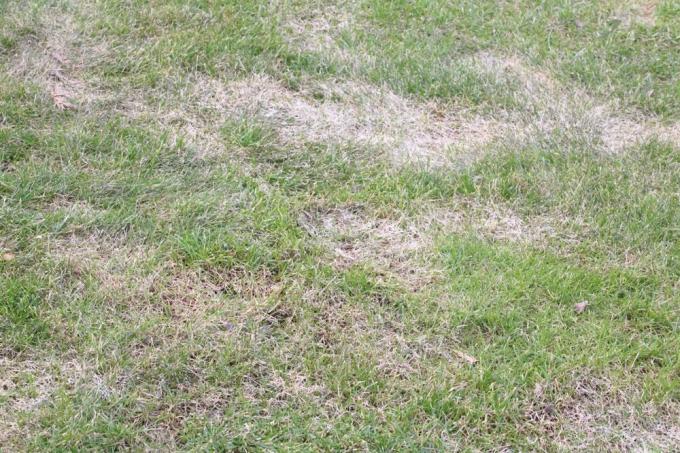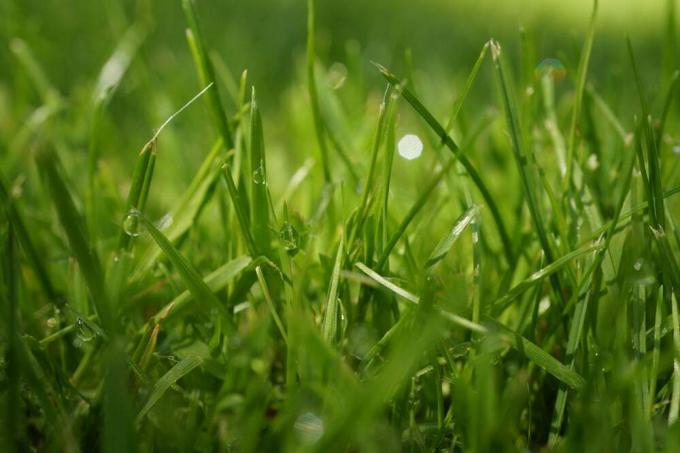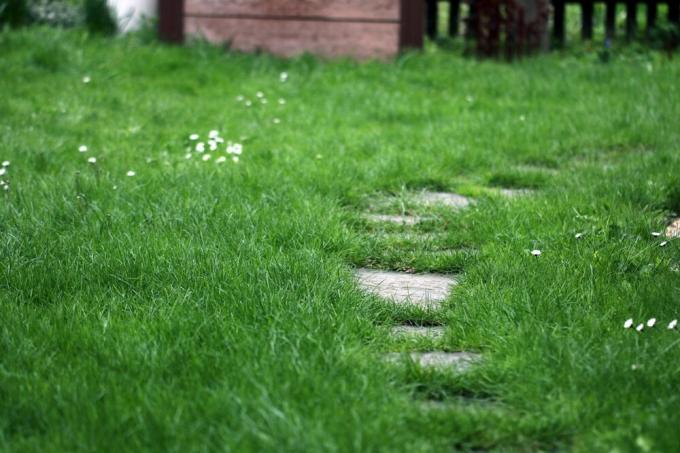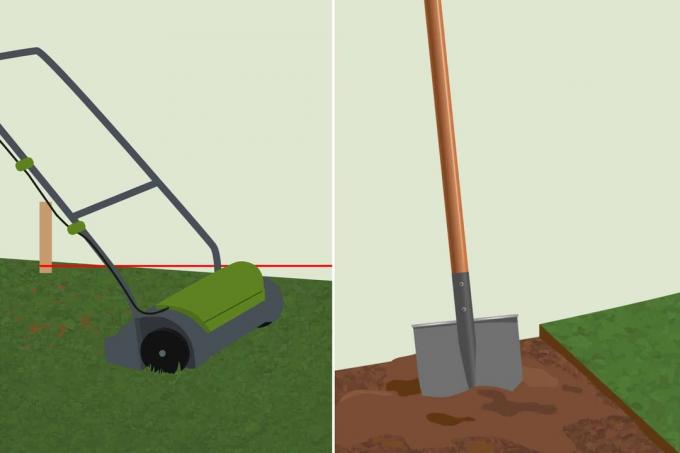

Table of contents
- Scarify properly
- Use in spring
- Perform in the fall
- Instructions: Scarify
The cold winter season and hot summer months put every lawn to the test. With the help of scarifying, garden owners can significantly improve the appearance and growth of their lawn. This care measure contributes significantly to the regeneration of the grass plants. The correct order and the right time are just as important as the technical execution. The dense carpet of grass then shines again in a rich shade of green.
Scarify properly
During the growing season, all sorts of residues accumulate on the lawn. These include old lawn clippings, wild weeds and rampant moss. Over time, these components compress into a dense mass that makes it difficult to absorb water. In addition, this leads to a reduced quality of the soil. As a result, the grass roots do not receive enough oxygen, and the supply of nutrients also deteriorates. As a result, the lawn looks sickly, thin and unkempt. The phenomenon is usually noticeable in spring, when only a few grasses start to grow. Scarifying the lawn has been established as a countermeasure. However, it is not recommended to use this method too often. Otherwise the grass plants will suffer instead of looking healthier.
- Important care measure for the grass surface
- Enables a healthy appearance
- Can be used as a rejuvenation and recovery cure
- Removes clover, moss and weeds
- Matted lawns are combed out
- Afterwards, grass roots can breathe better
- Nutrient supply to the roots is optimized
- Grass plants grow more lush and dense again
- Do not use scarifiers more than twice a year
- Ideally in spring and autumn
Use in spring

A good time for scarifying is spring. At this time of year, the soil including the lawn has a particularly fast ability to regenerate. However, this measure should not be carried out directly at the beginning of spring. After the cold winter months, the grass plants are still weak and react sensitively. In addition, the ground must no longer be frozen at the time of scarifying. Pleasantly warm temperature values are important so that the grasses can regrow in a timely manner. On the other hand, the lawn carpet suffers from severe heat and drought in the summer months, so that it can no longer recover sufficiently afterwards. In addition, there should always be fertilization at the beginning in order to strengthen the grass plants sufficiently. In addition, a certain sequence must be observed when proceeding so that the lawn is well prepared.
- The month of April is ideal for this care step
- Do not carry out until May after long winters
- Earth must be completely thawed
- Soil must not be completely dry
- A slightly moist soil is good
- Dry weather is ideal
- Temperatures of 10-20 °C are good
- Use nitrogenous fertilizer beforehand
- Then mow the lawn at least twice
- Carry out only in dry weather
- Lawn then grows more beautiful and lush green in summer
- Dispose of any plant material in the compost
- Sow grass seed in bare spots
A notice:
Before reaching for the scarifier, you should make sure that no hard frost periods are to be expected in the following days.
Perform in the fall

After the often very hot and dry summer months, the lawn often looks very poor. As a result, brown and bald spots have formed. Therefore, the procedure of scarifying can still be implemented quite well in autumn. The use of the scarifier is particularly necessary if the lawn carpet has been used intensively and mowed frequently. During this time of year the growth phase in the garden is coming to an end. The plants are beginning to really adjust to winter. Freeing the lawn from moss, plant residues and weeds is a useful preparation for the cold season. However, a few months must always elapse between the first and second part of the annual scarifying so that the grass is not overly stressed.
- The first real days of autumn are ideal
- Carry out earlier after rather cool summer months
- As early as mid to late August
- Set in later after warm summers
- Only in early to mid-September
- Dry weather with residual heat in the soil is ideal
- Wait for long periods of rain
- Afterwards, the wetness of winter can run off better
- The risk of compaction is reduced
- Then incorporate winter fertilizer
- Fertilizers with potassium are optimal
- Strengthen the resilience of the grasses
Tip:
You should complete the scarifying by mid-October at the latest. Otherwise the grasses will not have enough time to regenerate before the onset of winter.
Instructions: Scarify

If you treat your lawn to this recovery treatment every year, you will get a densely growing lawn carpet with a healthy turf. The grass surface then shines in a lush green, without moss and mulch from the previous months. However, this method does not make sense if a lot of rain has fallen. If the ground is too wet, it can quickly happen that the scarifier pulls out the entire turf. This leads to unsightly gaps. In addition, freshly laid lawns should never be treated with it. In addition, it is essential to avoid setting the scarifier too deep. If the result was not satisfactory in the spring, it is better to repeat the operation in the autumn after a rest period of a few months. As a rule, the lawn carpet is first scarified in a longitudinal direction. The next time, the treatment follows in the transverse direction.
- Lawn area must have grown for at least 2-3 years
- Prerequisite are deeply mowed grasses
- Maximum height may be 4 cm
- Grass must be absolutely dry
- Adjust the required height of the blades on the scarifier
- Suitable cutting depth is approx. 3mm
- Proceed deeper in extremely matted and overgrown areas
- Then a cutting depth of 5 mm is ideal
- Work the grass surface in even lines
- alternate direction each time
Tip:
A short test run with the scarifier gives you information about whether the device is working accurately and is set correctly. A less visible section of the lawn is suitable for this.
 garden editorial
garden editorial I write about everything that interests me in my garden.
Learn more about lawn care

Leveling out unevenness in the lawn: this is how it works
Unevenness in the lawn is annoying and poses a danger to gardeners, playing children and pets. There are a number of methods that can be used to level the lawn. We present them to you in our guide.

Leveling the lawn: how to smooth uneven surfaces
Dents and holes in the lawn are unsightly. We will show you step by step how to smooth uneven areas in the lawn again.

Algae in the garden | Lawn is slippery: what to do?
Algae love rainy days. Can the water seep badly into the ground, even better! The green, slippery mass is not only not a pretty sight, but also a danger for the lawn. Only those who act preventively and correctly in acute cases can avoid permanent damage.

Fighting fungi in the lawn | 10 tips against fungal infestation
Mushrooms in the lawn are not uncommon but annoying and sometimes even dangerous. This is especially true if the garden or green space is also used by pets and children. Here we will show you how to combat fungal infestation.

Aerate the lawn | Before or after mowing?
Sun, water, fertilizer and air are necessary for the lawn to grow. If the lawn does not get enough air, it cannot grow properly. We clarify when the right time to ventilate the lawn is.

Mulching with lawn clippings: 13 things to consider
Keeping the lawn short is a must for many hobby gardeners. However, if the lawn mower does not have a mulching function so that the grass clippings can remain on the lawn, the question arises as to where to put the waste. Because the compost heap is not a good solution here.



